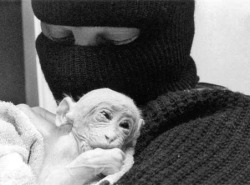
Image from Animal Freedom Fighters Unite Facebook group
More so than other factions of the Nonhuman Animal rights movement, the “liberation” or “direct action” faction (frequently associated with the Animal Liberation Front) often engages symbolism of human-to-human love, intimacy, and sex in its activist narrative.
Consider Love and Liberation: An Animal Liberation Front Story, a romance novel following a young female activist who falls in love with another direct action activist, the two of them bonding over illegal actions in the name of anti-speciesism.
Consider also the direct action comic, The Liberator, male-created with a male and female protagonist. The female-bodied hero, however, tends to be drawn for the male-gaze, large breasted and sometimes bra-less.
More than other factions of the movement, the direct action faction relies on narratives of heroism, machismo, and domination. As with any hero’s tale, the “girl as reward” must be present. In a previous essay, I note the “Liam Neeson effect,” whereby Nonhuman Animals are feminized and their plight exploited as a plot device to excuse hypermasculine vigilantism and violence. “Direct action” activism hopes to attract members and new recruits by creating an opportunity for boys and men to prove their manhood and become real-life superheroes. Steve Best, a leader of the ALF faction, has stated that it will be the media coverage of this type of activism which will motivate and inspire viewers to take up arms, so to speak. Love and sex must be part of this opportunity, as becoming a “man” necessitates power over the feminine.
Relatedly, ALF activists also frequently pose with Nonhuman Animals as loving and thankful. Most of these survivors are undoubtedly relieved, but we must keep in mind that media is not created by accident, and images are carefully chosen to convey a particular message. I see in this thankful animal trope the same patriarchal or paternalist concept: man as liberator and benevolent leader, woman and animal as grateful and dependent. Savior narratives, well-meaning though they may be, are inherently disempowering to the marginalized (this is a major concern in ally politics).
Social movements consciously strategize in their media representations, using particular codes that the audience will be expected to accurately and favorably interpret. The ALF and other direct action collectives bank on our cultural literacy with misogyny and patriarchy in order for these scripts and codes to make sense. I question as to whether or not this hypermasculine script will translate for an anti-oppression future if we’re still speaking the same language of domination.
 Dr. Wrenn is Lecturer of Sociology. She received her Ph.D. in Sociology with Colorado State University in 2016. She received her M.S. in Sociology in 2008 and her B.A. in Political Science in 2005, both from Virginia Tech. She was awarded Exemplary Diversity Scholar, 2016 by the University of Michigan’s National Center for Institutional Diversity. She served as council member with the American Sociological Association’s Animals & Society section (2013-2016) and was elected Chair in 2018. She serves as Book Review Editor to Society & Animals and is a member of the Research Advisory Council of The Vegan Society. She has contributed to the Human-Animal Studies Images and Cinema blogs for the Animals and Society Institute and has been published in several peer-reviewed academic journals including the Journal of Gender Studies, Environmental Values, Feminist Media Studies, Disability & Society, Food, Culture & Society, and Society & Animals. In July 2013, she founded the Vegan Feminist Network, an academic-activist project engaging intersectional social justice praxis. She is the author of A Rational Approach to Animal Rights: Extensions in Abolitionist Theory (Palgrave MacMillan 2016).
Dr. Wrenn is Lecturer of Sociology. She received her Ph.D. in Sociology with Colorado State University in 2016. She received her M.S. in Sociology in 2008 and her B.A. in Political Science in 2005, both from Virginia Tech. She was awarded Exemplary Diversity Scholar, 2016 by the University of Michigan’s National Center for Institutional Diversity. She served as council member with the American Sociological Association’s Animals & Society section (2013-2016) and was elected Chair in 2018. She serves as Book Review Editor to Society & Animals and is a member of the Research Advisory Council of The Vegan Society. She has contributed to the Human-Animal Studies Images and Cinema blogs for the Animals and Society Institute and has been published in several peer-reviewed academic journals including the Journal of Gender Studies, Environmental Values, Feminist Media Studies, Disability & Society, Food, Culture & Society, and Society & Animals. In July 2013, she founded the Vegan Feminist Network, an academic-activist project engaging intersectional social justice praxis. She is the author of A Rational Approach to Animal Rights: Extensions in Abolitionist Theory (Palgrave MacMillan 2016).
Receive research updates straight to your inbox by subscribing to my newsletter.



